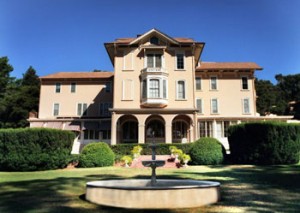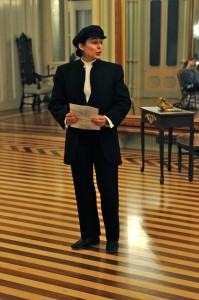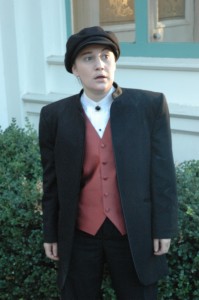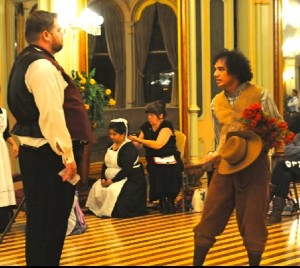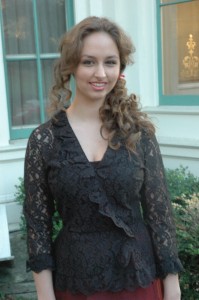Last month I had the privilege of attending a Grand Opera performance of Mozart’s¬† “perfect” opera, The Marriage of Figaro, performed by the San Francisco Opera at War Memorial Opera House.¬† I was one 3,000 or so present, and I enjoyed it tremendously.¬† If you’d like to read my review, click here.
Last night I had the privilege of attending an Intimate Opera performance Mozart’s¬† “perfect” opera, The Marriage of Figaro, performed by the Notre Dame de Namur music department in the Ballroom of Ralston Hall Mansion.¬† I was one of 100 or so present, and I enjoyed it tremendously.¬† The music was the same.¬† The performers were different but the characters were the same.¬† The language was different but this one was simply a¬† translation of that one.¬† But it was a totally different experience.
The experience began when we entered the NDNU campus in Belmont and drove up the steep narrow road to the magnificent mansion built in 1867.¬† I note that it was built nearer to the date of the premier performance of Figaro (1786) than to today’s date!¬† Charles found a parking space right next to the building.
We collect our tickets at the “box office”, an antique table set up in the spacious foyer, and proceed through the Cipriani Room and the Salon to our front row seats in the Grand Ballroom.
And Grand it is.  From its two-toned hardwood floors to its three large chandeliers hanging from its high ceiling.  From out-door views through the windows to the sconces and mirrors on the walls.  It is the perfect setting for the Mozart opera we are about to hear.  My excitement starts building even before anything happens.
Maestro Gregory Stapp comes on “stage” to welcome the audience and give the usual spiel about cell phones, then steps back, turns to begin the overture with the 5-person orchestra.¬† Since they are so few and since their musical sounds blended so well with the singers, they deserve to be named:
** Louise Costigan-Kerns (Piano & Harpsichord),
Weonsun Joo (Piano),
Elizabeth Morando (Flute),
James Tsai (Violin),
Alexis Flores (Violin),
** Ben Malkevaich (Cello)
[** = on NDNU faculty]
During the applause after the overture, the Maestro reverses his “podium” so he faces the stage from the rear, and Act I begins.
Seeing this intimate production up so close, I notice things that I had never thought of before in all the many times I have seen it.  For instance, the neat way that Mozart and da Ponte introduce their characters one or two at a time.  I want to follow that idea, but there are complications with regard to the pictures.  There were two different casts for four of the lead female parts, and the only action photos were from the dress rehearsal of the other cast.  Therefore, as I introduce each of those four roles, I will show two pictures: a rehearsal photo with the singer I did not see, and a posed photo of the singer I did see.  Got that straight?
Figaro is played in both casts by guest artist Rolfe Dauz, a senior at the San Francisco Conservatory of Music.¬† He does a great job, both singing and acting the part of an independent personal servant to perfection.¬† He has fun with his opening “measurement song”, measuring everything in sight but not monkeying with the words.¬† At one point he even hands one end of¬† his tape to a gentleman in the front row while measuring a piece of floor with the other.
As you can see from the picture “my” Susanna, Baily Batti, has an attractive face and¬† beautiful smile and she is a perfect foil for Rolfe’s Figaro; their voices blend nicely together. Those two young people were such a delight to watch and listen to.
Next to appear are Marcellina (Jenny Matteucci) and Dr. Bartolo (Richard Mix) – same singers for both casts.¬† Jenny is a student at NDNU and this is her first opera performance.¬† I’m sure it won’t be her last.¬† Her face suggests that she is not naturally skinny, but Costume Designer Kate Irvine Mills managed to pile enough additional padding on so that she is almost grotesque.¬† Richard is another guest artist with a fine deep voice who has been singing opera in the Bay area for almost 20 years.¬† I have heard him before in several roles with Pocket Opera.
Scene: Susanna alone in her room.¬† One by one three males show up to play the hilarious impromptu game of Musical Chair.¬† First, Cherubino skips in¬† complete with raging hormones and love letter to the Countess. The other Cherubino, Alexis Flores, receives her Bachelor of Music degree this year.¬† She is a versatile musician, doubling as Second Violinist in the orchestra when not actually on stage.¬† “My” Cherubino, Alanna Pinell, received her BFA from NDNU this year.¬† I had seen her in several productions before, including a real cute rendition as Papagena in The Magic Flute.¬† She has a delightful voice and lots of acting ability.¬† Her small stature is a definite asset when she curls up in the chair to hide and when she cowers before the wrath of Count Almaviva.
And Michael Reed, the Count in both casts is indeed someone to cower before.¬† A giant of a man with a deep voice to match and a definite star among the student performers.¬† He’s due to get his BFA in Musical Performance in 2011, so I hope I get to see him again.¬† I’ll never forget the light-footed way he moved his massive body about the stage as Jupiter (transformed into a fly by a pair of gauzy wings) in the Pocket Opera-NDNU joint production of Orpheus in the Underworld a couple of¬† years ago.¬† His performance Sunday shows that he continues to mature both as a singer and as an actor.
Don Basilio (Daniel G. Norberg), the prissy music master, gossip monger, and primp for the Count completes the performers in Act I.  Danny will get is MFA in Musical Performance in 2011.  I have seen him before in several roles, most notably as Monasteros in the Magic Flute. He also doubles in the cameo part of Don Curzio in the last act.
Before I introduce the last two characters who first appear in Act II, let me say a few words in praise of the blocking.¬† Director Gregory Stapp does a wonderful job of moving people around on the small stage, both when the stage is full, as in the wedding dance pictured above,¬† and when there are only a few people on stage.¬† An example of this that really caught my attention was the quartet by Susanna and the three men in her bedroom in Act I.¬† Here is what I wrote about that scene after seeing SFO’s production last June:
With all four on-stage characters now visible to each other we see and¬† hear one of Mozart’s signature treats: an ensemble of voices each singing his or her own version of events directly to the audience but in perfect harmony and counter-point.¬† In this case it’s a quartet, but sometimes it’s a trio or a sextet or whatever.¬† Susanna is singing about her narrow escape, and Cherubino about the trouble he is in with the Count.¬† The Count is bewailing his lost opportunity at seduction: “It’s all the fault of that damned page, but I can’t be too hard on him or he’ll spread the gossip.”¬† And Basilio is brimming over with delight at all the great gossip he’s picking up.
Now, make no mistake.¬† The sound of those four voices singing together was beautifully mixed and integrated by the time it reached Row R in the orchestra.¬† But I didn’t really notice to what extent the singers were moving as they sang because it made very little difference which voice was on the right and which on the left.¬† Further, the singers had it easy; all of the audience was in front of them so there was no question about which way to face.¬† The whole musical experience was very satisfying.
But it was a different order of magnitude Sunday night.¬† In my front row seat I was virtually in the middle of those four singers.¬† At any given moment I might hear the Count’s deep voice in my right ear from 4 feet away, Don Basilio’s lighter voice¬† from 14 feet in my left, and the two female parts from across the stage and all of 30 feet distant in both ears.¬† The genius of Gregory Stapp’s direction was that without being the least bit obtrusive, he kept those singers moving about and the vocal mix that reached my brain kept changing.¬† It was a fantastic experience.
An obvious complication of theater-in-the-semi-round is that a singer can’t face everyone in the audience at once.¬† Consequently sometimes one will have a side- or even a back-view of the singer.¬† But with the constant motion, no one view lasted long.¬† Frankly, I never noticed a change in voice quality whether or not I could see the singer’s lips moving.
Act II introduces the Countess Rosina.¬† Unfortunately, the only photograph available for “my” Countess ( Megan Conray) was the head-shot above right.¬† She is a “Performance Certificate” at NDNU who already holds BM and MM degrees from San Francisco State University.¬† I have seen her in other major roles with NDMU, most notably as Queen of the Night in Magic Flute and a terrific performance in the title role of Suor Angelica.¬† Suffice it to say that she fully lived up to my expectations.¬† The other Countess (Mary Garcia) received her BA in Music (Magna Cum Laude) and is currently pursuing her MFA.
The minor role of Antonio the gardener and uncle of Susanna was capably played by Freddie Navas.  I liked his accent during his recitative lines, but thought he overdid the drunken reeling a bit, particularly in his second appearance.  Freddie is a member of the Army National Guard Orchestra.  He is working on his BFA at NDNU but hopes to continue to an eventual MFA.
The final named cast member was Antonio’s daughter Barbarina.¬† “My” Barbarina, Jacqueline Kerns,¬† is shown in a posed shot above right taken during the intermission.¬† She is only a high school freshman at Menlo School, but she did a nice job with Barbarina’s small solo at the beginning of Act IV.¬† The other Barbarina, Leah Sawick, shown left is in her junior year at NDNU, working towards an MFA.
So these are the people I saw and loved Sunday evening.¬† I can’t urge you to go and see it, because that was the last of four performances held on two weekends.¬† But I can urge you to be on the lookout for future performances from this talented and imaginative group.¬† This is the first time they introduced this intimate venue – I hope it won’t be the last.¬† But they have shown great imagination before.¬† Both¬† Suor Angelica and Dialogues of the Carmelites were shown in their chapel – singularly apt for those particular operas.
You ask me, “But when all is said and done, which performance was better?”¬† That’s not a meaningful question.¬† It Ďs like asking me which is better, baseball or apple pie.¬† The two performances are different animals and I thought they were both great.¬† Let me rephrase the question: “If I could see one and only one of the two performances again next month, which one would I go to?”¬† I answer without hesitation: “The intimate performance at Notre Dame de Namur University.”
Ciao¬† –¬† –¬† –¬† –¬† –¬† –¬† The Opera Nut
This review by Philip G Hodge appeared in sanfranciscosplash.com on November 11, 2010.

